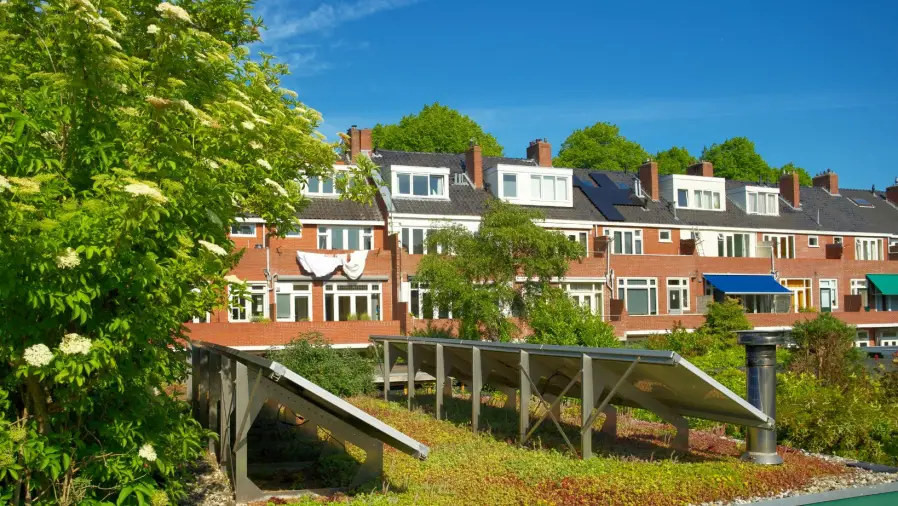Rooftop gardens mitigate urban heat island effect and enhance biodiversity. They help with stormwater management by absorbing rainfall.
Rooftop gardens represent a transformative solution for urban environments striving towards sustainability. By converting unused roof spaces into green areas, cities can combat the heat island effect, which often results in higher temperatures in urban areas compared to their rural counterparts.

These elevated oases support local ecosystems and provide habitat for a variety of pollinators and birds, boosting urban biodiversity. They act as natural sponges, reducing runoff during storms and lowering the risk of flooding. Furthermore, rooftop gardens can improve air quality by filtering pollutants and produce oxygen, contributing to a healthier urban atmosphere. Embracing vertical greening systems not only delivers environmental benefits but also can enhance the aesthetic appeal and potentially the property value of urban structures.
The Benefits Of Rooftop Gardens
Urban rooftops, often stark and unused, are increasingly transforming into lush, green oases, offering a breath of fresh air to city dwellers and the environment. Rooftop gardens bring a kaleidoscope of benefits, not only beautifying otherwise barren spaces but also serving as key players in urban ecological systems. Let’s delve into how these verdant spaces contribute significantly to environmental welfare.
Cooling Effect Of Rooftop Gardens
Rooftop gardens have a natural cooling effect, significantly lowering the temperature of the roof surface and the surrounding air. Through the process of evapotranspiration, plants release moisture into the atmosphere, helping to cool urban heat zones.
Reduction Of Urban Heat Island Effect
Rooftop gardens counter the urban heat island effect. Concrete and asphalt absorb and radiate heat, raising city temperatures. Rooftop greenery absorbs less heat, leading to cooler urban environments.
Energy Conservation And Reduced Air Conditioning Usage
Energy efficiency soars with rooftop gardens. The added insulation means buildings retain heat during winter and stay cool in summer, lowering dependence on heating and cooling systems, which curtails energy consumption and costs.
Improved Air Quality
Plants in rooftop gardens are natural air purifiers, absorbing pollutants and releasing oxygen. This significantly improves urban air quality, contributing to healthier cities.
Carbon Sequestration And Reduction Of Greenhouse Gases
By absorbing carbon dioxide, rooftop gardens play a crucial role in mitigating climate change. Plants sequester carbon from the atmosphere, reducing the concentration of greenhouse gases.
Filtration Of Airborne Pollutants
Rooftop gardens serve as a natural filter for airborne pollutants. They capture dust particles and other contaminants, leading to cleaner air and a healthier environment.
Biodiversity And Habitat Preservation
Urban biodiversity thrives with rooftop gardens, which provide habitats for a variety of insects, birds, and even small mammals, preserving ecosystems in the urban sprawl.
Creation Of Urban Wildlife Habitats
The addition of a rooftop garden creates invaluable habitats for urban wildlife, offering food, shelter, and breeding grounds to sustain diverse species.
Promotion Of Native Plant Species
Fostering native plant species, rooftop gardens support local flora and provide a connection to nature amidst the concrete jungle.
Stormwater Management
Rooftop gardens excel in managing stormwater by absorbing rainfall, reducing the burden on sewer systems, and minimizing the risk of flooding.
Reduction Of Runoff And Water Pollution
Through natural filtration, rooftop gardens reduce water runoff and filter pollutants, decreasing water pollution and preserving water quality.
Mitigation Of Urban Flooding
With their impressive water retention abilities, rooftop gardens mitigate the risks associated with urban flooding, serving as a sustainable solution during heavy rainfall events.
Community Well-being And Social Integration Through Green Spaces
Rooftop gardens contribute to community well-being, offering serene green spaces that foster social interaction and integration, while promoting mental and physical health benefits.
Frequently Asked Questions On How Do Rooftop Gardens Help The Environment
How Do Rooftop Gardens Reduce Pollution?
Rooftop gardens play a significant role in reducing urban air pollution. They absorb harmful pollutants and carbon dioxide, transforming them into oxygen. This natural filtration contributes to cleaner city air.
Can Rooftop Gardens Improve Biodiversity?
Yes, rooftop gardens create habitats for various species, fostering urban biodiversity. They attract birds, bees, and butterflies, which are crucial for pollination and maintaining ecological balance in city environments.
What Are The Thermal Benefits Of Rooftop Gardens?
Rooftop gardens provide thermal insulation for buildings. They help regulate indoor temperatures by absorbing sunlight and heat during summer, reducing the need for air conditioning, and insulating against cold in winter, lowering heating costs.
Do Rooftop Gardens Effectively Manage Rainwater?
Rooftop gardens are excellent for rainwater management. They absorb and retain rainfall, reducing runoff and lowering the risk of urban flooding. This stored water can also be used for irrigation, promoting water conservation.
Conclusion
Rooftop gardens are not just aesthetic enhancements. They’re a powerful tool against urban heat islands, air pollution, and biodiversity loss. They also boost building efficiency and lower energy costs. Embracing green roofs could be a game-changer for sustainable urban living.
Let’s cultivate these spaces for a greener future.
(To learn more about Small Rooftop Gardening Ideas : https://bonsainurserybd.com/5-small-space-rooftop-garden-ideas/)
